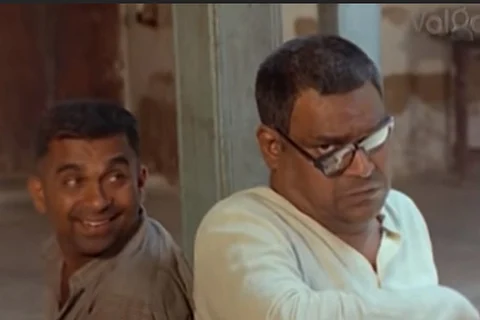

One of the many things that Jandhyala’s characters are adored for, is their highly specific and unique insults or ‘thitlu’. In Aha Naa-Pellanta!, it is Brahmanandam’s character who does most of the insulting, generously embellished with alliterations and absurd similes. Gaali vaanalo visenakarrelu ammevadi la moham chudu, for instance. (“You look like a man who sells hand fans during a storm.")
But we mostly hear these insults through his inner voice, because Aragundu (half-shaven head), as he is called throughout the film, is essentially in bonded labour under his boss and legendary miser Lakshmipathi (Kota Srinivasa Rao). It has been 33 years since the major hit and classic film Aha Naa-Pellanta! released, and it is these two characters (Aragundu and Lakshmipathi) who dominate the popular memory of the film. Brahmanandam debuted in cinema with Aha Naa-Pellanta!, and the past three decades of Telugu cinema are now inconceivable without him.
However, he is not the intended protagonist of the film. Aha Naa-Pellanta!, like most other films made by Jandhyala, are centered on characters from ‘middle-class’ or wealthy, landed families.
Krishnamurthy (Rajendra Prasad) is the son of a wealthy businessman in Hyderabad, Satyanarayana (Nutan Prasad). The latter is an indulgent widowed parent, but cannot allow Krishnamurthy’s love marriage with Padma (Ranjani), because of a tragic flashback and his wife’s dying wish.
Padma is the daughter of Lakshmipathi, the famous miser. Krishnamurthy’s father challenges him to win Lakshmipathi’s approval without revealing his identity as a millionaire’s son. And this is how Krishnamurthy ends up in a village in coastal Andhra, posing as a more ardent miser than Lakshmipathi, to dazzle his way into marrying his daughter.
The director of the film, Jandhyala, is today seen as an icon in Telugu comedy. Like a few other Jandhyala comedies (Padamati Sandhya Ragam, Srivariki Premalekha), Aha Naa-Pellanta! features an eccentric patriarch in Lakshmipathi who is a major nuisance to his family. While his wife and children are embarrassed and inconvenienced by his greed, Aragundu is the one who has to put up with his worst.
Aragundu ends up working for Lakshmipathi’s family because of his father’s debt. Lakshmipathi deducts his salary for any reason, from poor harvest to low rainfall to snide remarks. Aragundu is paid peanuts and is often forced to do ridiculous jobs.
Watching the film years later — when it’s largely associated with Brahmanandam and his very meme-able scenes from the film — the story seems to resolve not when the couple ends up together as we knew they would, but when Aragundu quits working for Lakshmipathi. This is also probably the first time he is called by his actual name Govindam by Krishnamurthy, lending dignity to his character right after he becomes free of Lakshmipathi.
Simply leaving is an unrealistic solution to his problems, and he has merely switched allegiance to a new boss (in Krishnamurthy, whom he promises to help him reach his own resolution). But there was empathy building for Govindam through all the comical harassment by Lakshmipathi, and his silent comebacks. The jokes are not at the expense of the worker, as is often the case, and it’s the landlord Lakshmipathi whom we are laughing at the entire time.
There are many dialogues from the film that came to be used commonly in conversations. For instance, the word “Naakenti?” (What’s in it for me?), which Lakshmipathi would say whenever someone tried to talk to him, asking them to pay him first. While more recent films and their dialogues are frequently woven into conversations, there has been a big change in the kind of Telugu used in these popular dialogues. To me, this change underlines the prevalence and even matter-of-factness of coastal Andhra dialect and culture in Telugu cinema back then — a culture that was quintessential to the Telugudanam (Teluguness) of popular Telugu cinema at the time.
Jandhyala is one of the filmmakers who is considered to be more progressive; he's lauded for having critiqued the social order of the day successfully through his writing, especially through his comedy.
Yet, looking back, some of the ways in which the humour is evoked in his films, through a hearing impairment or gluttony, for instance, don't sit well today. The most glaring instance that comes to mind is in Padamati Sandhya Ragam, where the drummer Sivamani plays an African-American man who is competing with a white man for Vijayashanti’s love. The white man gets the girl, while Sivamani’s mere desire for an upper-caste Telugu woman is portrayed as comedy.
On the other hand, the director also often mocked the families from wealthy and powerful communities in his films, for their orthodoxy, greed, exploitation and pomposity. The women usually actively express desire, which is unfortunately rare on screen, and also have fairly well-defined roles. In Aha Naa-Pellanta!, for instance, we are told that Padma goes to the rocks in the city outskirts to read Telugu, and she reads History at the cemetery and English by the railway tracks.
Even today, many Telugu filmmakers and comedians name Jandhyala as one of their influences. The effect he had on audiences and popular culture, was, of course, a product of the social and cultural moment in the ‘80s. His contributions, however, continue to be reproduced and reinterpreted through today’s internet culture.